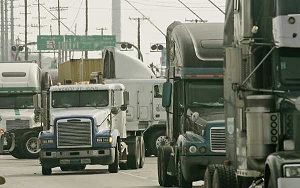Cracking down on diesel
 California can, and should, lead the world in ending the menace of soot and black carbon pollution from diesel engines.
California can, and should, lead the world in ending the menace of soot and black carbon pollution from diesel engines.We’ve all choked on black smoke billowing from diesel trucks and buses. It’s obviously polluting, but what’s not obvious is much worse. Diesel emissions are a major health hazard — cancer causing, in fact. And they are a big part of the threat to our climate.
Yet cleaning them up is practical, easy and affordable — the rules just need to be enforced.
On June 12, the World Health Organization classified diesel particulate matter (soot) as a Group 1 “known carcinogen,” adding it to an ugly list of chemicals that includes asbestos and cigarette smoke. The Environmental Protection Agency estimates that several thousand Americans die each year from diesel pollution.
Diesel pollution also causes respiratory diseases such as asthma and bronchitis. And, if all this isn’t bad enough, black carbon, a major component of diesel emissions, is second only to carbon dioxide as a harmful climate disrupter and greenhouse gas.
A third of Americans and most Californians live in areas with dangerous levels of air pollution, including diesel particulates, that fail to meet the minimum air quality standard set by the EPA under the 1970 Clean Air Act. Low-income communities near major transportation centers and ports are disproportionately hurt.
And in general, the problem is getting worse. Our economy is ever more dependent on diesel trucks, buses and construction equipment, and on ports, where ships, trucks, service vehicles and refrigeration units all use diesel fuel. So even though EPA standards on new diesel engines have reduced particulate matter pollution, the overall rapid growth in the use of diesel-powered vehicles and in the miles they drive offsets much of the pollution reduction. Diesel engines last a long time — heavy-duty diesel vehicles generally stay in operation for 15 to 30 years.
There is a solution for dealing with particulate pollution from even the oldest diesels. Engines can be retrofitted with a filter that reduces toxic particulate emissions by 85% or more. The filter isn’t unproven technology: More than 50,000 retrofitted diesel filters are in operation in the U.S. today.
Retrofitting a truck costs about $10,000. That’s not cheap, but if the truck has 10 years of life remaining, it’s only $1,000 a year. Why “only”? Because a 18-wheeler traveling 75,000 miles a year and getting about 7 miles per gallon (that’s a generous estimate) will consume about $40,000 a year in diesel fuel at its current price, so $1,000 isn’t a large fraction of the annual operating cost .
As important, according to the EPA, is that every $1 spent on diesel emission reductions saves about $13 in healthcare costs, in addition to creating jobs for local truck dealers and filter manufacturers.
California’s Air Resources Board is responsible for enforcing regulations relating to particulate emissions coming from diesel-powered trucks and buses. It mandates that all heavy-duty diesel vehicles comply with the most recent EPA particulate matter standards or be retired, with some leeway for trucks close to the end of their life span.
Some companies, such as Coca-Cola, have moved rapidly to clean up their fleets and advertise that fact. The ports of Los Angeles, Long Beach and Oakland, in partnership with local citizens’ groups, have made good progress toward replacing dirty diesel engines. But neither market forces nor voluntary compliance are enough.
A survey done by filter manufacturers shows that only about half the trucks that the air resources board mandated be retrofitted last year and this year have actually come into compliance.
We shouldn’t be surprised. Every effort to clean up diesel pollution was vigorously fought by backward companies in the industry. Before 2007, the manufacturers of diesel engines even designed their computers so that after an engine passed pollution control tests, its pollution control equipment would be turned off. (Many of these “cheater” trucks are still on the road.)
The problem now is not with regulation but with enforcement. The state’s enforcement of its rules on trucks and buses has been slow and inadequate. Without strong enforcement, trucking companies will simply avoid the cost of compliance at the expense of the health of the exposed population.
We as citizens must rely on the air board; we can’t protect ourselves. But the regulators can’t do their job without our support — they have an enormous workload, tight budgets and no immunity from special-interest pressure. Lack of public awareness and lack of public pressure make it harder for regulators to enforce the law.
California has the opportunity to lead the nation on this problem. And on air cleanliness in the U.S., when California leads, the rest of the nation gets healthier. In the last month the air resources board has begun filing enforcement actions — but public support is needed to improve the state’s focus on this critical problem.
You can return to the main Market News page, or press the Back button on your browser.

